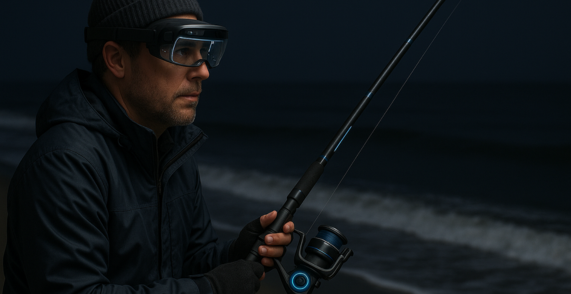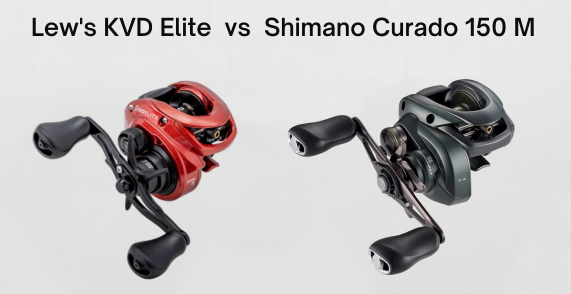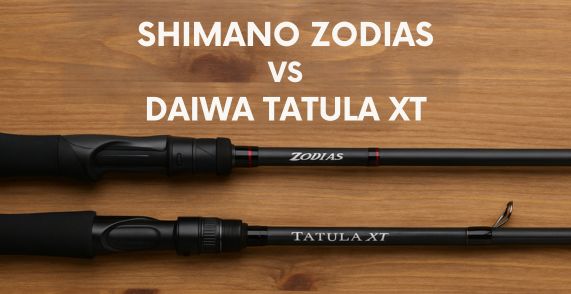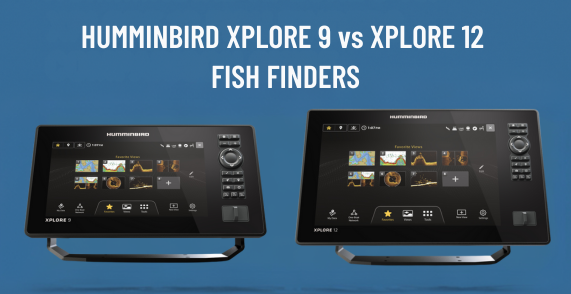In This Post
- 1 Key Takeaways
- 2 Fish Smarter, Not Harder: How Tech is Revolutionizing Night Surf Fishing
- 3 Smart Rod Technology: Your Digital Fishing Partner
- 4 Seeing in the Dark: AR Displays and Sonar Integration
- 5 Strategic Illumination: Science-Based LED Lighting Systems
- 6 The Connected Shore: Power and Data Management
- 7 Mobile Apps as Your Fishing Command Center
- 8 The Investment Spectrum: From Basic Tech to Complete Systems
- 9 Finding Your Balance: When Technology Enhances Rather Than Replaces Skill
Key Takeaways
- Smart fishing rods with AI-enhanced sensors can now analyze environmental data in real-time, helping night surf anglers locate fish more effectively without losing the skill element of fishing.
- AR glasses integrated with sonar systems overlay critical underwater data in your field of vision, allowing you to maintain visual awareness of waves and surroundings during night fishing.
- Green LED lights at 520 nm wavelength have been scientifically proven to be most effective for attracting fish during night sessions.
- The fishing sensor market is projected to grow from $1.2 billion in 2024 to $2.8 billion by 2033, indicating rapidly expanding technology adoption.
Fish Smarter, Not Harder: How Tech is Revolutionizing Night Surf Fishing
Night surf fishing has changed dramatically from the days of simply attaching glow sticks to rod tips. Today’s tech-savvy anglers use an integrated ecosystem of smart rods, augmented reality displays, and scientific lighting systems that transform what was once a game of chance into a strategic pursuit. Fishing Zenith has been at the forefront of documenting this technological revolution, helping anglers navigate the expanding world of fishing technology.
The modern night surf angler faces unique challenges – limited visibility, unpredictable surf conditions, and the need to detect subtle bites amidst constant wave action. Rather than diminishing these challenges, new technologies help anglers overcome them while preserving the fundamental skills that make fishing rewarding.
Smart Rod Technology: Your Digital Fishing Partner
1. AI-Enhanced Bite Detection Systems
The foundation of tech-enhanced surf fishing begins with the rod itself. Modern smart rods like the Abu Garcia Virtual incorporate sophisticated sensors that transform a traditional fishing rod into an intelligent tool.
These rods feature embedded microelectronics that detect not just fish bites but also analyze the surrounding environment in real-time.
Smart bite detection systems utilize accelerometer technology to identify the specific vibration patterns of a fish strike. Unlike basic electronic bite alarms, these advanced systems can differentiate between a genuine bite and environmental factors like wave action or wind.
This capability is particularly valuable during night surf fishing, where visual confirmation of a bite is difficult.
“The technology isn’t replacing your skills – it’s extending your senses beyond human limitations,” explains a review from an experienced surf angler who tested the Abu Garcia Virtual rod system during multiple night sessions.
2. Environmental Monitoring Capabilities
Beyond bite detection, today’s smart rods serve as environmental monitoring stations. Integrated sensors collect and analyze data including:
- Water temperature gradients that might indicate feeding zones
- Subtle current changes that affect bait presentation
- Barometric pressure shifts that trigger feeding activity
- Water clarity levels that influence lure selection
This environmental intelligence helps night surf anglers make informed decisions about where to cast, which baits to use, and how to adjust retrieval techniques based on real-time conditions rather than guesswork.
3. Performance Tracking and Cast Analysis
Smart rods equipped with motion sensors provide detailed analytics on your casting performance – a game-changer for surf anglers who need maximum distance and accuracy in challenging conditions.
These systems track casting distance and accuracy metrics, retrieval speed variations and their correlation with successful hookups, and provide historical performance data to identify patterns of success.
This data, synchronized with catch information, creates a powerful feedback loop that helps anglers refine their techniques specifically for night surf conditions.
The combination of environmental monitoring and performance tracking transforms the fishing experience from reactive to proactive, with anglers making data-driven decisions rather than relying solely on instinct.
Seeing in the Dark: AR Displays and Sonar Integration
1. Wireless Sonar Performance in Dynamic Surf Conditions
The unpredictable nature of surf zones creates unique challenges for sonar technology. However, advancements in castable sonar units have overcome many of these limitations, making them practical tools for night surf fishing.
Modern units like the Deeper PRO+ can be cast up to 300 feet offshore and maintain wireless connections even in challenging conditions.
These compact devices create their own Wi-Fi networks, transmitting real-time underwater data to your smartphone or AR display without requiring cellular service. The most effective units for surf fishing feature:
- Multiple frequency settings to adapt to varying water clarity and turbulence
- Narrow beam options for detailed structure scanning in calmer water pockets
- Wide beam capabilities for general area scanning in rougher conditions
- GPS integration for mapping underwater contours and channels
The true innovation lies in how these devices maintain accurate readings despite the dynamic surf environment. Advanced signal processing algorithms filter out wave-induced noise, providing clearer returns than earlier generation units.
2. Hands-Free AR Data Overlays
Professional bass fisherman Ed Loughran pioneered the integration of AR glasses with fishing sonar, a technique now being adopted by forward-thinking surf anglers.
This approach addresses a critical safety concern in night surf fishing – the need to maintain visual awareness of incoming waves and surrounding hazards while accessing data.
AR glasses like the U-Track project a virtual screen in the angler’s field of view, displaying sonar data, GPS coordinates, and environmental metrics without requiring them to look down at a smartphone.
This hands-free approach is particularly valuable in the surf zone, where taking your eyes off the water can be dangerous.
The integration options continue to expand, with systems like:
- XREAL Air Pro 2 glasses connected via USB-C to smartphones
- Apple Vision Pro with LiveScope integration for premium visualization
- Raymarine Wi-Fish app compatibility for dedicated marine electronics users
3. Real-Time Fish Location and Structure Mapping
The combination of sonar and AR creates a powerful system for understanding underwater topography that would otherwise be invisible at night.
These systems provide real-time overlays showing fish location with size estimation, underwater structures like sandbars and troughs, depth changes, and temperature gradient visualizations that help identify feeding zones.
This technology eliminates much of the guesswork in night surf fishing. Instead of blind casting and hoping, anglers can target specific underwater features where fish are likely to congregate.
The AR overlay essentially creates a “see-through” effect, making water clarity irrelevant for locating productive areas.
Strategic Illumination: Science-Based LED Lighting Systems
1. The 520nm Green Light Advantage for Attracting Fish
Scientific research has confirmed what some night anglers have known intuitively – not all light colors are equally effective for attracting fish.
Green LED lights at approximately 520 nanometers wavelength have proven most effective for night fishing applications. This specific light wavelength penetrates water more effectively and triggers a feeding response in many fish species.
The science behind this is fascinating. The green light creates a food chain reaction:
- Plankton and microorganisms are drawn to the green light
- Smaller baitfish are attracted to the concentrated plankton
- Larger predatory fish follow the baitfish into the illuminated zone
Modern underwater LED systems designed for surf fishing feature impressive specifications:
- Powerful 1000+ lumen output that can illuminate large areas
- IP68 waterproof ratings to withstand complete submersion
- Multiple color options with green being predominant for most applications
- 12-24V DC power compatibility for flexible power source options
2. Smart Control Features and Remote Operation
Today’s lighting systems go beyond simple on/off functionality with intelligent features that maximize effectiveness while conserving battery life.
Advanced systems now offer automated depth adjustment that maintains optimal positioning around 2 feet below the surface, smartphone app control for adjusting brightness and color, programmable timer functions that prevent battery drainage, and multi-zone lighting capabilities for creating strategic illumination patterns.
These smart features allow night surf anglers to create customized lighting strategies based on target species and conditions.
Some anglers use programmable flash patterns that simulate baitfish activity, while others prefer steady illumination that creates a consistent feeding zone.
The Connected Shore: Power and Data Management
1. Marine-Grade Battery Solutions for Extended Sessions
Reliable power is the foundation of any tech-enhanced night fishing setup. The energy demands of multiple electronic devices require thoughtful power management strategies.
Modern solutions include marine deep-cycle batteries that provide stable power output over extended periods, solar charging systems for maintaining battery levels during multi-day trips, and portable power banks with USB-C capability for quick-charging mobile devices.
The most successful night surf anglers implement redundant power systems. Primary equipment runs on dedicated marine batteries, while backup devices like smartphones can be recharged from separate portable power banks.
This approach prevents a single power failure from compromising the entire system.
2. Creating a Reliable Tech Ecosystem in Harsh Environments
The surf zone’s combination of salt spray, sand, and moisture creates a uniquely hostile environment for electronics. Protecting this technology requires specialized cases, connections, and maintenance protocols.
Effective protection strategies include marine-grade waterproof cases with IP67 or higher ratings, corrosion-resistant connections with gold-plated or marine-grade contacts, silica gel packets inside electronics cases to absorb moisture, and regular cleaning routines using electronics-safe solutions.
Connectivity between devices presents another challenge. Most tech-enhanced fishing systems rely on a combination of Bluetooth, Wi-Fi, and occasionally cellular connections.
Creating a reliable network requires careful selection of compatible devices and understanding their communication range limitations.
Mobile Apps as Your Fishing Command Center
1. Environmental Analysis and Predictive Fishing Times
Smart fishing applications have grown beyond simple weather forecasts. Today’s specialized fishing apps integrate multiple data streams to provide sophisticated environmental analysis and predictive capabilities.
These apps combine weather data, tide information, solunar calendars, and historical catch reports to calculate optimal fishing periods with remarkable accuracy.
Advanced applications like Fishbrain utilize machine learning algorithms that analyze millions of fishing reports to identify patterns that human observation might miss.
This technology can predict with increasing accuracy when specific species are most likely to be active in particular locations based on environmental conditions.
Key features of these predictive systems include:
- Real-time barometric pressure tracking with alerts for optimal fishing conditions
- Tide phase calculations specific to your precise GPS location
- Moon phase impact analysis on fish feeding behavior
- Water temperature trend monitoring with historical comparisons
For night surf anglers, these predictive tools help maximize limited fishing time by focusing efforts during peak activity periods. Rather than spending hours waiting for action, anglers can plan their sessions around algorithmically-determined prime times.
2. GPS Catch Logging and Hotspot Mapping
Precise location tracking has transformed how anglers record and analyze their fishing spots. Modern apps allow for highly detailed catch logging with exact GPS coordinates, creating personal hotspot maps that become increasingly valuable over time.
The most sophisticated applications integrate with smart rod sensors to automate this process.
When a fish is caught, the system records the exact location along with environmental conditions, tackle used, and even fighting time. This creates a comprehensive database that grows more valuable with each fishing trip.
Some systems take this concept further with bathymetric mapping capabilities. By combining catch data with underwater contour information, these apps create three-dimensional representations of productive areas.
This is particularly valuable in surf fishing, where subtle changes in bottom structure can concentrate fish in specific zones.
The power of this technology comes from its ability to reveal patterns over time. An angler might discover that a particular species consistently appears along a specific depth contour during certain tide phases – intelligence that would take years of traditional observation to gather.
3. Community Insights and Pattern Recognition
While personal data is valuable, the true power of modern fishing apps comes from their community aspects.
Platforms like Fishbrain have built communities of millions of anglers who contribute to a collective knowledge base that far exceeds what any individual could compile.
These community-driven features include:
- Anonymized catch data showing species distribution and seasonal movements
- Trend analysis revealing which baits and techniques are producing results
- Real-time reports from other anglers in your area
- Species-specific insights based on aggregated catch data
The most advanced applications employ sophisticated pattern recognition algorithms to analyze this community data, identifying correlations between successful catches and environmental factors, tackle choices, or techniques.
This transforms anecdotal fishing wisdom into data-driven intelligence that can be applied to improve success rates.
The Investment Spectrum: From Basic Tech to Complete Systems
1. Entry-Level Enhancements Under $200
Technology doesn’t have to break the bank to improve your night surf fishing experience. Strategic investments in entry-level tech can provide significant benefits without requiring a major financial commitment.
Cost-effective technology upgrades include:
- Basic electronic bite alarms ($30-50) that alert you to strikes
- Clip-on smart sensors ($90-150) that track environmental data and log catches
- Entry-level castable sonars like the Deeper START ($90-100)
- Specialized fishing apps with premium subscriptions ($5-10 monthly)
These modest investments can dramatically improve the night surf fishing experience by eliminating some of the most common frustrations.
A simple bite alarm, for instance, frees you from constantly watching rod tips in the dark, while a basic castable sonar provides crucial information about underwater structure that would otherwise be invisible.
2. Professional-Grade Integrated Setups
For the committed angler seeking maximum advantage, professional-grade integrated systems represent the cutting edge of fishing technology. These comprehensive setups combine multiple advanced components that work together as a unified system.
A complete professional setup might include premium smart rods with integrated sensors, advanced castable sonar with mapping capabilities like the Deeper CHIRP+2, AR glasses with sonar integration, programmable LED lighting systems, and marine-grade power management solutions.
The total investment for a complete professional system can easily exceed $2,000, representing a significant commitment.
The true value of these integrated systems comes from the synergy between components. When your smart rod, sonar, and AR display work together as a unified system, you gain capabilities that far exceed what any single device could provide.
Finding Your Balance: When Technology Enhances Rather Than Replaces Skill
The integration of technology into fishing has sparked passionate debate among anglers. Some traditionalists argue that excessive reliance on technology diminishes the skill element that makes fishing rewarding.
Others embrace these tools as enhancements that allow them to apply their skills more effectively.
The reality is more nuanced than either extreme position. Technology doesn’t replace fundamental fishing skills – it transforms how those skills are applied.
Reading water, understanding fish behavior, and mastering bait presentation remain essential, but technology provides new information that helps anglers apply these skills with greater precision.
The most successful tech-enhanced anglers maintain this balance by:
- Using technology to gather information, not make decisions
- Developing a deep understanding of how their tools work and their limitations
- Continuing to hone traditional skills like reading water and weather
- Viewing technology as a complement to, not a replacement for, experience
This balanced approach recognizes that while a smart rod can tell you when a fish bites, it can’t tell you how to fight and land that fish. A sonar can reveal structure, but understanding why fish relate to that structure still requires knowledge and experience.
AR glasses can display data, but interpreting that data and making tactical decisions remains a human skill.
Ultimately, fishing technology is simply a new set of tools in the angler’s arsenal. Like any tool, its value depends entirely on how it’s used.
In the hands of a skilled angler who understands its capabilities and limitations, modern fishing technology doesn’t diminish the sport – it opens new dimensions of possibility while preserving the fundamental connection between angler, environment, and quarry.







